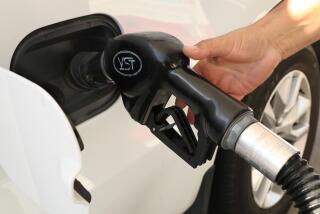Had Your Fill of the Modern...
- Share via
These days, as the interstates cut concrete swaths across the desert and back-lit corporate logos zip by like giant lollipops at 75 mph, it’s easy to miss the past, lingering and decaying just off the offramps.
The funky old gas stations that once promised cheap fuel, clean toilets, free road maps and, most of all, safe harbor, long ago were replaced by the stark, polished steel islands of the big petroleum companies where folksiness takes a back seat to efficiency.
Now considered little more than automotive necessities, gas stations grew up with the American automobile industry and the country’s obsession with driving, evolving from entrepreneurial showcases of schlock and service to mechanized convenience stations just as likely to offer slushies and shaving cream as gas.
“New gas stations are a little harder to come to terms with,” said John Margolies, New York author of “Pump and Circumstance: Glory Days of the Gas Station.”
“They don’t have any soul, but they are well designed, better designed in many ways than the old ones were.”
Back in the days when cars were novelties and a trip to Barstow was still an exotic voyage, gas stations were “way stations. They were your home away from home,” Margolies said. “They were cultural as well as sociological icons.”
Individual vendors vied for attention along two-lane roads with giant thermometers and stations shaped like pumps or designed like Greek temples. Service stations were not only a place to fill the tank, but a place to grab a cola, inflate the tires and chew the fat.
In the earliest days of the horseless carriage, filling up was a feat in itself. Service stations were still decades away and drivers bought gas by the bucket at local dry goods stores or livery stables, carrying it home and pouring it through a strainer and funnel into the tank.
In turn-of-the-century Los Angeles, the Gilmore Oil Company patrolled neighborhoods in horse-drawn tankers, selling gas door to door. A sign tacked to the side promised: “Some day you will own a horseless carriage. Our gasoline will run it.” Forty years later, Gilmore was among the first vendors in Southern California to offer customers the option of serving themselves in giant stations at a savings of a nickel per gallon.
By about 1910, primitive pumps designed by Sylvanus P. Bowser were fairly common outside general stores. The pumps were generally installed right on the curb outside a store and customers often blocked traffic as they filled up.
The early pumps clanged to mark off every gallon or so, but suspicious customers soon began to wonder if they were truly getting what they were paying for because they could not see the gas making its way into the tank.
So pumps with glass tops began appearing to show customers that gasoline was actually flowing through the hose. Petroleum companies even began dyeing their gas different colors to set apart what was basically the same product from pump to pump.
Soon, the first true service stations began to appear across the country, but they looked almost nothing like modern facilities. A 1916 Atlantic Refining Company station in Philadelphia looked more like a mausoleum than a filling station with its glazed terra cotta tile and Greek-inspired design.
In fact, early gas station architects wanted their stations to look distinguished and refined because the car was still considered in many quarters to be a noisy, dirty and generally obnoxious deathtrap.
In Milwaukee, the Wadhams Oil Company designed its stations to look like Japanese teahouses, complete with red tile roofs and ornate towers. Others were topped with copper domes and accented with Classical arches and columns.
Historian Kenneth T. Jackson wrote in “Crabgrass Frontier: The Suburbanization of the United States” that the designs got so outlandish that a cartoonist once mocked them with an illustration of a newcomer confusing a gas station with the state capitol.
During the 1920s and early 1930s, gas stations generally were operated by individual business people who contracted with big oil companies. Because they were selling essentially the same product at similar prices, they were forced to outdo each other with more outrageous designs and promotions, said Ken Love, a designer who helped Texaco change its appearance in the early 1980s.
But by the late 1930s, more and more oil companies were opening their own stations or requiring franchises. Homogenization became the rule. Architects hired by the corporate headquarters stamped out designs that could be replicated on corner after corner across America.
Similar designs made it easier for motorists to notice brand names, the beginning of a corporate iconography that pervades life to this day. For instance, who doesn’t recognize the golden arches? As the interstate highway system was built during the 1950s and 1960s, that sort of instant recognition became crucial as drivers hurtled past the eclectic but unrecognized independent stations.
Individual companies competed for business by promoting their service and cleanliness. The “man with the star” became a shorthand for knowledgeable and helpful attendants. Unocal dispatched a contingent of nationwide restroom inspectors known as the Sparkle Corps.
Yet even as homogenization spread across the country, individual operators still stood out. Bob’s Airmail Service on Wilshire Boulevard incorporated a twin-engine plane into its design, using the wings as protective eaves over the pumps. And in Cloquet, Minn., architect Frank Lloyd Wright allowed to be built in 1958 the gas station he envisioned for his never-achieved dream of Broadacre City.
At stations everywhere, young men hung out and fiddled with their muscle cars in the service bays and chatted with their friends. Gradually, though, the love affair with the car began to mellow. The gas crunch of the early 1970s drove smaller operators out of business.
Then, cars became more and more complicated. Specialty mechanics replaced the general knowledge of service station attendants. And quick-serve shops promising 10-minute oil changes and discounted tires undercut service stations’ traditional businesses. Soon gas stations evolved yet again into prefab awnings covering dozens of self-serve pumps and a bulletproof cage for the cashier.
But the true killer of independent gas stations were federal environmental regulations in the early 1980s requiring the replacement of old underground tanks. Once the tanks were removed, many small operators could not afford to clean the soil and were forced to close.
Studies show the change. Along 1.7 miles of University Avenue in Champaign, Ill., there were 23 gas stations in 1959, but only five in 1989. Another study in San Diego recorded a drop in stations along El Cajon Boulevard from 52 in 1950 to 11 in 1988.
What replaced them? Mini-malls.
And many gas stations have come full circle--once again requiring motorists to serve themselves outside a small general store, as they did when the Ford Model A was new.
More to Read
Sign up for Essential California
The most important California stories and recommendations in your inbox every morning.
You may occasionally receive promotional content from the Los Angeles Times.










